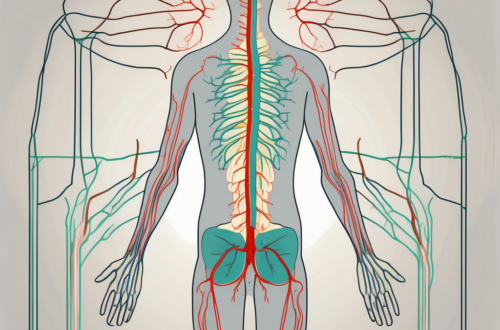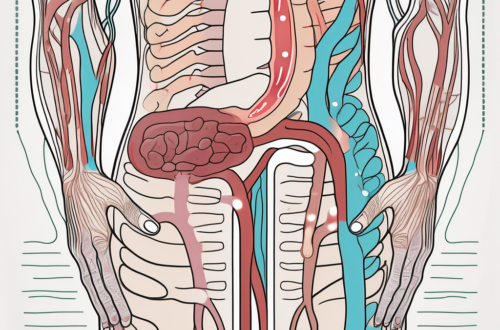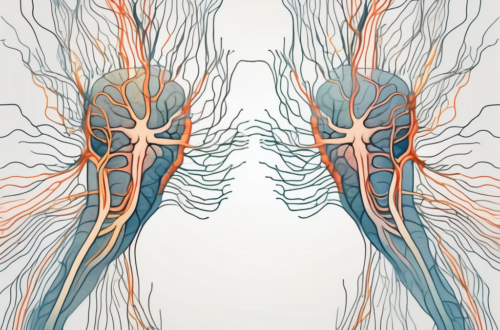An epidural parasympathetic nerve block is a valuable medical procedure that offers numerous benefits for patients. In this article, we will delve into the science behind this technique, explore its common uses in medical practice, and uncover the significant advantages it offers to patients. Additionally, we will provide insights into the procedure itself, potential risks and complications, and address some frequently asked questions to ensure a comprehensive understanding of the topic. Moreover, we will shed light on the future of epidural parasympathetic nerve block, highlighting ongoing research and potential new applications in medicine.
What is an Epidural Parasympathetic Nerve Block?
An epidural parasympathetic nerve block is a medical procedure that involves injecting an anesthetic near the parasympathetic nerves in the epidural space of the spinal cord. This technique provides localized pain relief by temporarily blocking the transmission of pain signals from the affected area to the brain. By targeting the parasympathetic nervous system, which controls various involuntary bodily functions, this procedure can offer a range of benefits for patients with specific medical conditions or undergoing certain surgeries.
The Science Behind the Procedure
Understanding the science behind epidural parasympathetic nerve block is essential to comprehend its therapeutic effectiveness. The epidural space is located outside the protective covering of the spinal cord and contains blood vessels, fat, and nerve roots. By carefully administering an anesthetic in this space, the parasympathetic nerves can be targeted, inhibiting pain signals from reaching the brain.
It is important to note that the parasympathetic nervous system plays a crucial role in regulating bodily functions such as heart rate, digestion, and bladder control. By selectively blocking the parasympathetic nerves, the procedure can provide targeted pain relief without affecting other vital bodily functions.
When the anesthetic is injected into the epidural space, it diffuses and spreads around the nerve roots, numbing the area and preventing the transmission of pain signals. This localized effect allows patients to experience relief from pain without the need for systemic medications that may have unwanted side effects.
Furthermore, the anesthetic used in epidural parasympathetic nerve block is carefully chosen to ensure optimal pain relief. Different types of anesthetics, such as lidocaine or bupivacaine, may be used depending on the specific needs of the patient and the duration of pain relief required. The dosage and concentration of the anesthetic are also carefully determined to achieve the desired effect.
Common Uses in Medical Practice
The utilization of epidural parasympathetic nerve block extends across various medical fields, reflecting its versatility and effectiveness. Commonly, this procedure is employed for pain management in conditions such as chronic back pain, cancer-related pain, and neuropathic pain.
Chronic back pain can be debilitating and significantly impact a person’s quality of life. By targeting the parasympathetic nerves responsible for transmitting pain signals from the affected area, epidural parasympathetic nerve block can provide long-lasting relief and improve the daily functioning of individuals suffering from this condition.
Cancer-related pain is another area where epidural parasympathetic nerve block has shown promising results. For patients with advanced cancer, pain can be a significant burden that affects not only physical well-being but also emotional and psychological health. By effectively blocking pain signals, this procedure can offer much-needed relief and improve the overall quality of life for these patients.
Neuropathic pain, which is caused by damage or dysfunction of the nerves, can be challenging to manage. Epidural parasympathetic nerve block can be a valuable tool in the treatment of neuropathic pain, providing targeted pain relief and improving the daily functioning of individuals affected by this condition.
Moreover, epidural parasympathetic nerve block has demonstrated its value in surgical settings, particularly for procedures involving the lower abdomen, pelvis, and lower extremities. By providing effective pain relief after surgery, patients can experience a more comfortable postoperative period, facilitating early mobilization and speedy recovery.
Additionally, this procedure can reduce the need for systemic pain medications, which may have unwanted side effects such as nausea, drowsiness, or constipation. By minimizing the use of these medications, patients can have a smoother recovery and potentially avoid complications associated with their use.
In conclusion, epidural parasympathetic nerve block is a valuable medical procedure that offers targeted pain relief by blocking the transmission of pain signals. Its scientific basis lies in the careful administration of anesthetics in the epidural space, targeting the parasympathetic nerves responsible for pain sensation. This procedure finds applications in various medical fields, providing relief for chronic back pain, cancer-related pain, neuropathic pain, and postoperative pain. By offering localized pain relief, epidural parasympathetic nerve block can improve patients’ quality of life and facilitate their recovery.
The Benefits of Epidural Parasympathetic Nerve Block
The benefits of epidural parasympathetic nerve block extend beyond pain relief, positively impacting various aspects of patient care and recovery. Let us explore some of the notable advantages:
Pain Management and Control
One of the primary advantages of epidural parasympathetic nerve block is its ability to effectively manage and control pain. By targeting the parasympathetic nerves responsible for transmitting pain signals, this procedure provides localized pain relief, allowing patients to experience a significant reduction in discomfort. As a result, individuals can regain their ability to engage in daily activities, significantly improving their quality of life.
Moreover, the pain management and control offered by epidural parasympathetic nerve block can have a profound impact on mental well-being. Chronic pain can lead to feelings of frustration, anxiety, and depression. By alleviating pain, this procedure can help enhance the patient’s mood and overall psychological state, promoting a more positive outlook on life.
Speedy Recovery and Rehabilitation
By alleviating pain and facilitating early mobilization, epidural parasympathetic nerve block contributes to a speedy recovery and rehabilitation process. Patients who undergo surgeries, especially in the lower abdomen, pelvis, or lower extremities, can benefit greatly from the pain relief provided by this procedure.
Furthermore, the ability to engage in early mobilization is crucial for preventing complications such as blood clots and muscle atrophy. With reduced pain, individuals are more likely to engage in rehabilitation exercises and regain their strength and mobility at a faster pace. This accelerated recovery not only allows patients to return to their normal activities sooner but also reduces the risk of long-term disability.
Reduced Need for Systemic Medication
Epidural parasympathetic nerve block offers an added advantage by reducing the need for systemic medication. Often, chronic pain or postoperative pain requires the administration of strong pain medications that can have detrimental side effects.
By effectively managing pain at its source, this procedure minimizes the reliance on systemic medications, reducing the likelihood of adverse reactions and opioid-related complications. This not only benefits the patient’s physical health but also reduces healthcare costs associated with the use of expensive medications and potential hospital readmissions.
Additionally, the reduced need for systemic medication can have a positive impact on the patient’s overall well-being. Many pain medications can cause drowsiness, nausea, and other unpleasant side effects. By avoiding these systemic medications, patients can experience improved alertness, better appetite, and an overall better quality of life during their recovery.
The Procedure of Epidural Parasympathetic Nerve Block
Understanding the procedure of epidural parasympathetic nerve block is crucial for patients considering this intervention. Familiarize yourself with the key components:
Pre-procedure Preparation
Prior to the procedure, patients will undergo a comprehensive evaluation by a healthcare professional. This evaluation will involve a detailed medical history assessment and potential imaging studies to ensure the appropriateness and safety of the procedure. Patients should openly communicate any relevant medical conditions, allergies, or ongoing medications to the healthcare provider. This information allows the medical team to tailor the procedure to the individual’s needs and mitigate potential risks.
During the evaluation, the healthcare provider will take the time to explain the procedure in detail, addressing any concerns or questions the patient may have. This open communication helps build trust and ensures that the patient is fully informed and prepared for the upcoming intervention.
In addition to the medical evaluation, patients may also be required to undergo certain pre-procedure preparations. This can include fasting for a specific period of time, discontinuing certain medications that may interfere with the procedure, or arranging for transportation to and from the clinic or hospital.
During the Procedure
The procedure itself is typically performed in a specialized clinic or hospital setting. Patients will be positioned comfortably, and the skin around the chosen injection site will be sterilized. Local anesthesia will be administered to numb the area, ensuring minimal discomfort during the procedure.
Prior to the administration of anesthesia, the healthcare provider will explain the process and its expected effects. This helps alleviate any anxiety or fear the patient may have and allows them to feel more at ease during the procedure.
The healthcare provider will use fluoroscopy or ultrasound guidance to precisely locate the desired injection site. This advanced imaging technology provides real-time visualization, allowing for accurate needle placement and minimizing the risk of complications.
Once the injection site is identified, a thin needle will be inserted into the epidural space. The healthcare provider will proceed with caution and precision, ensuring that the needle is correctly positioned to target the parasympathetic nerves.
During the injection, the healthcare provider will administer a small amount of anesthetic medication. This medication helps block the parasympathetic nerves, reducing pain and promoting relief. The healthcare provider may adjust the needle’s position if necessary to ensure accurate targeting of the nerves.
Post-procedure Care
After the procedure, patients will be monitored closely for a short while to ensure their comfort and safety. It is not uncommon to experience temporary numbness or a reduction in pain following the injection. However, each patient’s response may vary.
The healthcare provider will provide specific post-procedure instructions, which may include limitations on physical activities, observation of any adverse effects, and follow-up appointments to assess the effectiveness of the intervention. These instructions are crucial for the patient’s recovery and overall well-being.
In some cases, patients may be advised to keep a pain diary to track their progress and provide valuable information for future treatment decisions. This diary can help the healthcare provider understand the extent of pain relief achieved and make any necessary adjustments to the treatment plan.
It is important for patients to communicate any concerns, unusual symptoms, or unexpected side effects to their healthcare provider. This open line of communication ensures that any potential issues are addressed promptly, promoting a successful recovery.
Overall, the procedure of epidural parasympathetic nerve block is a carefully orchestrated intervention that aims to alleviate pain and improve the patient’s quality of life. By understanding the pre-procedure preparation, the steps involved during the procedure, and the post-procedure care, patients can make informed decisions and feel confident in their treatment journey.
Potential Risks and Complications
As with any medical intervention, epidural parasympathetic nerve block carries potential risks and complications. Understanding these possibilities is crucial for making informed decisions. It is important to note that serious adverse events associated with this procedure are rare, but they can occur. Always consult with a healthcare professional to discuss individual risks and benefits specific to your circumstances. Some potential risks and complications include:
Understanding the Risks
Complications associated with epidural parasympathetic nerve block may include infection, bleeding, nerve damage, allergic reactions, or unintended spread of the anesthetic to other areas. Though rare, these risks require consideration and appropriate medical guidance.
Infection is a potential risk that can arise from any invasive medical procedure. However, healthcare professionals take extensive precautions to minimize the risk of infection during epidural parasympathetic nerve block. Strict adherence to infection control protocols, such as proper hand hygiene, sterilization of equipment, and the use of sterile drapes, significantly reduces the likelihood of infection.
Bleeding is another potential complication that can occur during or after the procedure. The insertion of the needle into the epidural space carries a small risk of damaging blood vessels, leading to bleeding. However, healthcare providers are trained to carefully navigate the needle to minimize this risk. Additionally, patients with bleeding disorders or those taking blood-thinning medications may be closely monitored to ensure their safety during the procedure.
Nerve damage is a rare but serious potential complication of epidural parasympathetic nerve block. The needle used during the procedure can, in rare cases, cause damage to the nerves in the surrounding area. This can result in temporary or, in extremely rare cases, permanent loss of sensation or function. However, healthcare professionals utilize imaging guidance, such as fluoroscopy or ultrasound, to ensure accurate needle placement and minimize the risk of nerve damage.
Allergic reactions to the anesthetic used in epidural parasympathetic nerve block are possible, although they are rare. The anesthetic medication, such as lidocaine or bupivacaine, can cause an allergic response in some individuals. Healthcare providers will carefully review a patient’s medical history and perform allergy testing if necessary to identify any potential allergies and choose the appropriate medication for the procedure.
Unintended spread of the anesthetic to other areas is another potential risk of epidural parasympathetic nerve block. The anesthetic is intended to target specific nerves in the epidural space, but there is a small chance that it may spread to surrounding areas, affecting unintended nerves. Healthcare providers take precautions, such as using the lowest effective dose of the anesthetic and monitoring the patient closely during the procedure, to minimize this risk.
Mitigating Potential Complications
Medical professionals take precautions to minimize the potential risks and complications associated with epidural parasympathetic nerve block. Thorough patient evaluation, adherence to infection control protocols, utilization of imaging guidance, and appropriate follow-up care all contribute to the overall safety of the procedure. Communication with your healthcare provider is essential to assess your specific risks and take necessary measures to mitigate potential complications.
Prior to undergoing an epidural parasympathetic nerve block, a comprehensive evaluation will be conducted to assess your overall health and identify any factors that may increase your risk of complications. This evaluation may include a review of your medical history, physical examination, and possibly additional tests or consultations with specialists.
Infection control protocols are strictly followed during the procedure to minimize the risk of infection. Healthcare providers will thoroughly clean the injection site and use sterile equipment and drapes to create a sterile field. They will also wear gloves and other protective gear to prevent contamination.
Imaging guidance, such as fluoroscopy or ultrasound, is often used during epidural parasympathetic nerve block to ensure accurate needle placement. This helps healthcare providers avoid unintended structures, such as blood vessels or nerves, reducing the risk of complications such as bleeding or nerve damage.
After the procedure, appropriate follow-up care is essential to monitor for any potential complications and ensure proper healing. Your healthcare provider will provide instructions on post-procedure care, including any restrictions or activities to avoid. They will also schedule follow-up appointments to assess your progress and address any concerns or complications that may arise.
Overall, while there are potential risks and complications associated with epidural parasympathetic nerve block, healthcare professionals take extensive measures to minimize these risks. By thoroughly evaluating each patient, adhering to infection control protocols, utilizing imaging guidance, and providing appropriate follow-up care, the safety and effectiveness of the procedure are maximized. Open communication with your healthcare provider is key to understanding your individual risks and ensuring the best possible outcome.
Frequently Asked Questions about Epidural Parasympathetic Nerve Block
Addressing common concerns and queries can help individuals develop a clearer understanding of epidural parasympathetic nerve block. Here are answers to some frequently asked questions:
Is the Procedure Painful?
The procedure itself aims to minimize discomfort and pain. Local anesthesia is administered to numb the area of the injection site, reducing any potential pain. However, it is normal to experience a temporary discomfort or pressure sensation during the procedure.
How Long Does the Effect Last?
The duration of pain relief following an epidural parasympathetic nerve block can vary depending on the individual and the specific medical condition being treated. Some patients may experience pain relief lasting for days or weeks, while others may require repeated procedures to maintain the effect. Consultation with a healthcare professional is crucial to establish reasonable expectations and potential maintenance strategies based on individual requirements.
Future of Epidural Parasympathetic Nerve Block
The future of epidural parasympathetic nerve block looks promising, with ongoing research and developments aimed at enhancing patient outcomes. Scientists and medical professionals are continually exploring innovative techniques, refining current protocols, and investigating potential new applications in medicine.
Ongoing Research and Developments
Ongoing research seeks to further optimize the selection criteria for patients who will benefit the most from epidural parasympathetic nerve block. This research aims to identify individuals who will achieve the greatest pain relief, helping healthcare providers tailor the procedure to individual needs more effectively. Additionally, researchers are exploring alternative medications and delivery methods to improve efficacy and minimize potential side effects.
Potential New Applications in Medicine
With its well-established benefits, epidural parasympathetic nerve block has the potential for new applications within the medical field. Researchers are investigating its use in various conditions, including but not limited to chronic pelvic pain, post-herpetic neuralgia, and certain gastrointestinal disorders. The expansion of its scope could offer novel solutions for patients suffering from diverse medical ailments, ultimately improving their quality of life.
In conclusion, understanding the benefits of epidural parasympathetic nerve block is essential for patients and healthcare professionals alike. This impactful procedure provides targeted pain relief, aiding in pain management, facilitating speedy recovery, and reducing the need for systemic medications. However, it is crucial to consult with a healthcare professional to assess individual circumstances, risks, and benefits. As medical research continues to advance, the future holds even greater potential for epidural parasympathetic nerve block, paving the way for enhanced patient care and outcomes in various specialties.





